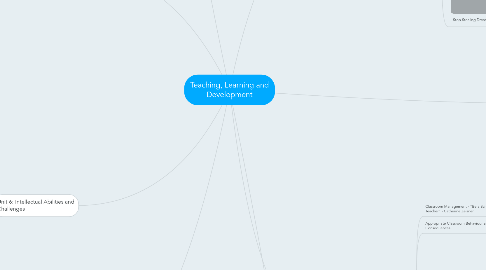
1. Unit 4: Making Instructional Decisions
1.1. 10 Day Timetable
1.1.1. Team Pause Day
1.2. “Inquiry ... requires more than simply answering questions or getting a right answer. It espouses investigation, exploration, search, quest, research, pursuit, and study. It is enhanced by involvement with a community of learners, each learning from the other in social interaction.” (Kuklthau, Maniotes & Caspari, 2007, p. 2
1.3. Teacher Checklist
1.4. Universal Instructional Design - Considering the needs of all students - "Equitable accessibility and utility" (Edmunds & Edmunds, 2015, p 127)
1.5. SOLE Classroom
1.6. Motivation
1.7. Metacognition
1.7.1. Thinking about thinking
1.8. Information Processing: 1) Select - 2)Organize - 3)Integrate
1.8.1. 1) Sensory Memory - 2) Working Memory - 3) Long-Term Memory
2. Unit 5: Assessment
2.1. Backwards Design
2.2. Blooms Taxonomy
2.2.1. 1. Knowledge 2. Comprehension 3. Application 4. Analysis 5. Synthesis 6. Evaluation
2.3. Stiggins's Achievement Targets
2.3.1. Hierarchy of Achievement Targets, focus on development of 1) use of knowledge with specific thinking processes 2) preferred attitudes and dispositions students should have on academic endeavours. (Edmunds & Edmunds, 2015, p 125)
2.4. Diagnostic Assessment - Before Instruction
2.5. Formative Assessment - During Instruction
2.6. Summative Assessment - After Instruction
2.7. Questions
2.8. Criterion-Based Assessment
3. Unit 6: Intellectual Abilities and Challenges
3.1. Intelligence
3.1.1. Caroll's Hierarchical Model of Intellegence
3.1.1.1. Fluid – Basic brain function Crystallized – long term, experience Visual/Spatial – Thinking in pictures
3.1.2. Gardner's Theory of Multiple Intellegences
3.1.3. Sternberg's Triarchic Theory of Intelligence
3.1.3.1. Analytical/Componential Intelligence - basic thinking processes Creative/Experiential Intelligence - Insight, coping with new experience Practical/Contextual Intelligence - understanding self
3.2. Exceptionalities
3.2.1. High-incidence
3.2.2. Low-incidence
3.3. Inclusion
3.4. Special Education
3.4.1. IEP's
3.5. Differentiated Instruction
3.6. Temperaments
3.6.1. Easy Students
3.6.2. Difficult Students
3.6.3. Slow-to-warm-up Students
4. Unit 7: Socio-Cultural Considerations
4.1. Perspectives
4.1.1. Individualism
4.1.2. Collectivism
4.2. Stereotype Threat
4.3. Socio-Economic Status
4.3.1. "by far the greatest impact on scholastic achievement." (Edmunds & Edmunds, 2015, p 254)
4.4. Aboriginal Education
4.4.1. Risk factors vs Protective Factors
4.4.1.1. Early intervention, leadership skills, parental involvement, community involvement, connection to Aboriginal role models and support
4.5. A Culturally Responsive Practice
4.5.1. Critical Consciousness
4.5.2. Bank's Dimensions of Multicultural Education
4.5.2.1. Content Integration
4.5.2.2. Prejudice Reduction
4.5.2.3. Empowering School Culture
4.5.2.4. Equity Pedagogy
4.6. Parenting Styles
4.6.1. Authoritarian
4.6.2. Permissive
4.6.3. Authoritative
5. Unit 8: Standardized Tests
5.1. Controversy/Debate
5.1.1. Stress Inducing, taxpayer accountability, teacher debate, undermining learning, student improvement, curriculum changing
5.2. Achievement Tests
5.2.1. Criterion-Referenced
5.3. Aptitude Tests
5.3.1. Norm-Referenced
5.4. Administered to a large group, containing the same questions for everyone, under the same conditions, graded under the same systematic manner
5.4.1. Five Essential Elements
5.4.1.1. Assessment of teachable curriculum goals
5.4.1.2. Clear Description of Assessed Knowledge and Skills
5.4.1.3. Specific enough to guide instruction
5.4.1.4. Minimally intrusive
6. Unit 1: Planning for the School Year
6.1. Schwab's Four Common Places
6.1.1. Teacher
6.1.2. Student
6.1.3. Topic
6.1.4. Setting
6.2. Students are Responsible for their own Learning
6.3. Curricular Planning
6.3.1. Educational Purpose
6.3.2. Learning Experiences
6.3.3. Evaluation
6.4. Constructivism - "Students develop their own cognitive structures and actively construct their knowledge and skills." (Edmunds & Edmunds, 2015)
6.5. Educational Psychology Research - Cyclical process
6.5.1. Validity
6.5.2. Reliability
6.5.3. Qualitative
6.5.4. Quantitative
6.6. Stop Stealing Dreams - Seth Godin
7. Unit 2: Child Development
7.1. Nature vs. Nurture
7.2. Development is Orderly, but not constant
7.3. Piaget - Four Stages of Development
7.3.1. 1. Sensorimotor 2. Preoperational 3. Concrete Operations 4. Formal Operations
7.4. Vygotsky's Zone of Proximal Development
7.4.1. Scaffolding, supported learning
7.5. Cognitive Equilibrium
7.5.1. Innate Drive to Equilibrium
7.6. Growth Mindset
7.7. Childish Thinking - Adora Svitak
8. Unit 3: Positive Learning Environment
8.1. Classroom Management - "Be a School Teacher" - Catherine Zeisner
8.2. Appropriate Classroom Behaviour and their Consequences
8.2.1. Student Self Control
8.3. Tips for better Classroom Management
8.3.1. 1. Build Community 2. Design a Safe, Friendly, and Well-Managed Classroom Environment 3. Include Students in Creating Rules, Norms, Routines, and Consequences 4. Create a Variety of Communication Channels 5. Always Be Calm, Fair, and Consistent 6. Know the Students You Teach 7. Address Conflict Quickly and Wisely 8. Integrate Positive Classroom Rituals 9. Keep It Real Partner with Parents and Guardians
8.4. Every Kid Needs a Champion - Rita Pierson
8.5. Every Child is Unique
8.5.1. Know your students
